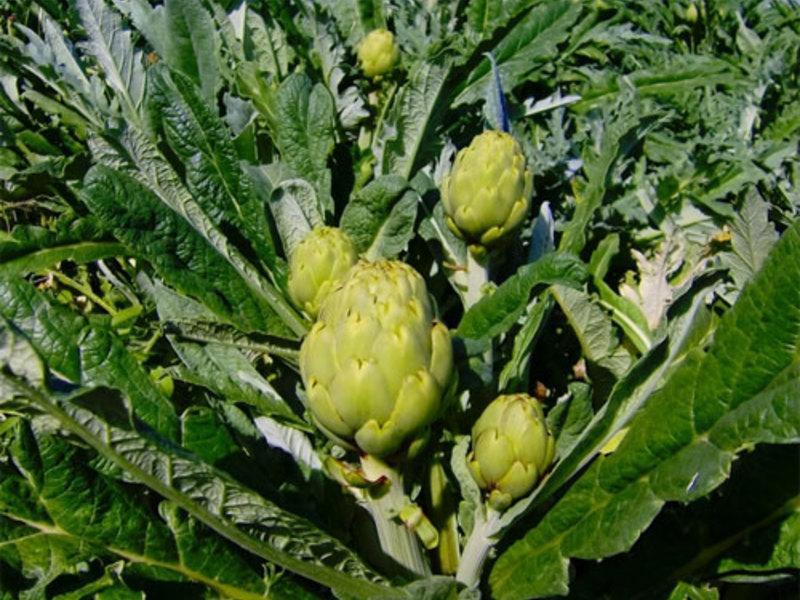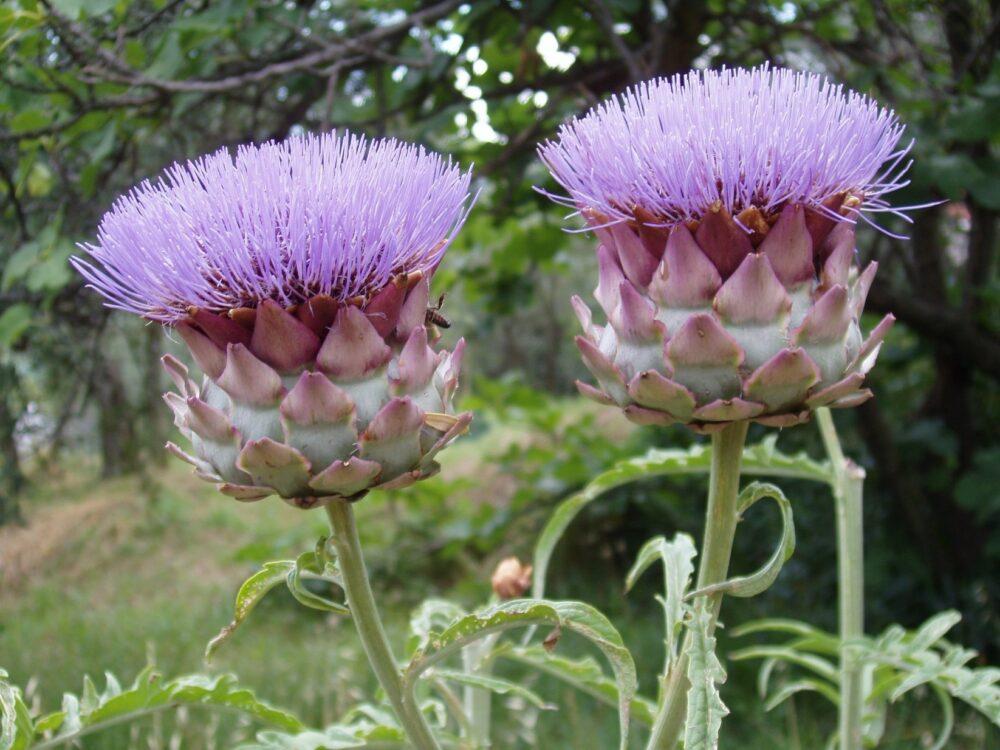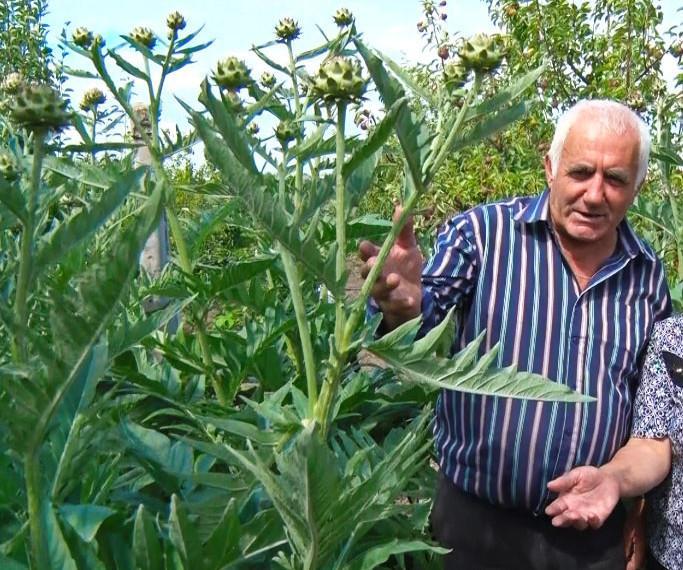Do you have a unique artichoke growing in your garden?
 Artichoke is an exotic plant with an unusual name and no less unusual look. Everyone has heard about him, but few people had the opportunity to personally meet him, and even more so there is. And to grow ... This process is considered impossible and difficult. In fact, there are no problems with growing an artichoke.
Artichoke is an exotic plant with an unusual name and no less unusual look. Everyone has heard about him, but few people had the opportunity to personally meet him, and even more so there is. And to grow ... This process is considered impossible and difficult. In fact, there are no problems with growing an artichoke.
Fruit, vegetable, hybrid?

And yet, what does an artichoke look like? Well, have you seen a thistle? Here is something similar to it. This is nothing more than an unblown bud of a flower, containing many fleshy petals, which is used for food.
 Distinctive features of a perennial are: a taproot that tolerates winter well, large lobed leaves, a straight stem, the height of which can reach more than 1.5 m.Also attention is drawn to huge inflorescences, up to 10-12 cm in diameter, resembling baskets in appearance, covered many scales. If the plant is allowed to bloom, the buds open with the appearance of blue tubular flowers.
Distinctive features of a perennial are: a taproot that tolerates winter well, large lobed leaves, a straight stem, the height of which can reach more than 1.5 m.Also attention is drawn to huge inflorescences, up to 10-12 cm in diameter, resembling baskets in appearance, covered many scales. If the plant is allowed to bloom, the buds open with the appearance of blue tubular flowers.
Miracles of reproduction
 The artichoke reproduces in two ways: from seeds and by root processes. Growing an artichoke in the Moscow region and regions of central Russia is best done in seedlings. And in the southern regions, you can use the seedless method.
The artichoke reproduces in two ways: from seeds and by root processes. Growing an artichoke in the Moscow region and regions of central Russia is best done in seedlings. And in the southern regions, you can use the seedless method.
Root layers
 If the artichoke is an adult, then in the second year of life it is able to release root processes. If they are separated, and properly planted and grown in care, they will grow into full-fledged plants. For planting, choose the young that has acquired three strong leaves, and very carefully separate the process from the mother plant. Next, the shoots are planted in the ground as described above and looked after.
If the artichoke is an adult, then in the second year of life it is able to release root processes. If they are separated, and properly planted and grown in care, they will grow into full-fledged plants. For planting, choose the young that has acquired three strong leaves, and very carefully separate the process from the mother plant. Next, the shoots are planted in the ground as described above and looked after.
Growing an artichoke from seeds
 The plant is quite rare in our country, so it is easier to find seed material than adult bushes.
The plant is quite rare in our country, so it is easier to find seed material than adult bushes.
As a rule, 15 artichoke seeds are sold. in one package. Sowing begins in the first week of March, not forgetting to prepare them in February. For this, the seeds are placed in a container, poured with water and left for 10-12 hours until they swell.
Take water that is settled or clean artesian at room temperature.
Then the seeds are laid out on a cloth, wrapped in it, a film is wound on top and sent to a warm place for 5 days. When the seeds hatch, a bag of seeds is sent to the refrigerator for 2 weeks, placing it on the bottom shelf.
This preparation process is called stratification and can significantly increase the chances of flowering and fruit formation right in the year of planting.
Substrate preparation and sowing
The next stage of growing an artichoke is preparing a container in which the seedlings will be grown. These should be boxes of a convenient size for you. At the bottom, drainage is first poured, and on top is a substrate consisting of sifted sand, sod land and humus, taken in the same ratio. Thoroughly mixed components must be moistened.
On the surface of the soil, grooves are made with a depth of 1-1.5 cm, where the seeds are placed, placing them at a distance of 3-4 cm from each other. From above, the seeds are covered with earth no more than 1 cm thick.Do not make a greenhouse or cover it with glass and film. The main thing that should be controlled is the moisture content of the soil - it should not dry out.
The sprouts will appear in a few days. When the first leaf is formed, it is advisable to increase the backlight and reduce the temperature to 15 degrees. Otherwise, the stems of the plant will stretch out. Watering should be moderate, as the artichoke does not like wet feet.
Picking and leaving
 If the seeds were planted in several pieces in one container, they should be opened, preferably in 0.5 liter peat pots filled with a mixture of humus, earth and sand.
If the seeds were planted in several pieces in one container, they should be opened, preferably in 0.5 liter peat pots filled with a mixture of humus, earth and sand.
In order not to injure the plants, you should water the main container and only then take out the young.
A small hole is made in the soil, the first sprout is taken out, the central root is pinched off and planted in a pot. Watered seedlings are sent to a bright and warm place.
 Two weeks after planting, the plants are fertilized with a mullein diluted with water in a ratio of 1:10, and after another 2 weeks - mineral fertilizers... From now on, you can harden the young by taking it outside for a few minutes and increasing this period to 10 hours, not forgetting to shelter it from the sun and rain.
Two weeks after planting, the plants are fertilized with a mullein diluted with water in a ratio of 1:10, and after another 2 weeks - mineral fertilizers... From now on, you can harden the young by taking it outside for a few minutes and increasing this period to 10 hours, not forgetting to shelter it from the sun and rain.
Landing in open ground
 Now let's look at how to grow an artichoke outdoors. The plant is planted in mid-May on the southern slopes, where there is nutritious and airtight soil.
Now let's look at how to grow an artichoke outdoors. The plant is planted in mid-May on the southern slopes, where there is nutritious and airtight soil.
If the plant goes to feed animals, it is planted in the garden, after digging up the ground and adding superphosphate, humus and potassium sulfate in an amount of 0.2 kg, 10 kg and 40 g, respectively, per 1 m2... In this case, it is necessary to form beds 20 cm in height at a distance of a meter from each other. The plants are planted so that there is a distance of 80 cm between them.The planted young are watered and mulch straw or dried grass.
 If the artichoke is grown for decorative purposes, it is planted where it can be properly cared for, such as in the garden or on the front lawn. At the same time, a hole is prepared 50 cm deep and 70 in diameter, a mixture of compost with sod soil is introduced and seedlings are planted at a distance of 1.5 m between specimens. From above, mulching is carried out with grass.
If the artichoke is grown for decorative purposes, it is planted where it can be properly cared for, such as in the garden or on the front lawn. At the same time, a hole is prepared 50 cm deep and 70 in diameter, a mixture of compost with sod soil is introduced and seedlings are planted at a distance of 1.5 m between specimens. From above, mulching is carried out with grass.
Harvesting and preservation
 Basically, the fruits from the plant can be harvested only in the second year. Fruiting in the first year is very rare. At the end of summer, the plant produces peduncles, which are ready for cutting in two weeks.
Basically, the fruits from the plant can be harvested only in the second year. Fruiting in the first year is very rare. At the end of summer, the plant produces peduncles, which are ready for cutting in two weeks.
The buds ripen in different ways, so each one needs separate control.
You can determine whether you need to cut the flower or not by the upper scales. As they begin to open and bend - the hour has come. If blue petals began to crown the top of the flower, you missed the time, the bud is overripe and you can't eat it anymore.

You need to cut the artichoke together with the stem, leaving a "tail" of 4-5 cm. As for the shelf life, they vary from 2 to 12 weeks, depending on storage conditions.
Despite its exotic origin, the artichoke is not at all difficult to grow for our gardens. Now you know where the artichoke grows, how to grow it correctly, and if you decide to plant this plant in your home, your table will be replenished with a variety of dishes from a tasty and healthy product.